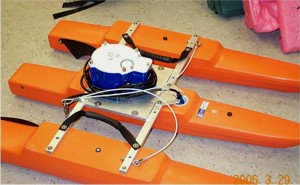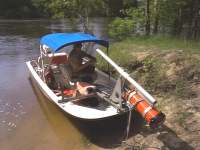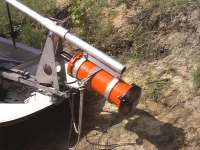Moving-Boat Deployments
Every measurement site has unique features that may determine the best type of ADCP deployment platform. Site features may include hydraulic characteristics such as water velocity and access considerations such as the presence of boat ramps, bridges, or cableways. Three common types of ADCP deployment platforms are manned boats, tethered boats, and remote-control boats. The Streampro is deployed only on a tethered boat but has two tethered boat options.
Manned Boats and Mounts
ADCPs can be mounted on either side of manned boats, off the bow, or in a well through the hull. Advantages and disadvantages for mounting locations on manned boats are listed in table 3. The ADCP should not be mounted in close proximity to any object containing ferrous metal or sources of strong electromagnetic fields, such as generators, batteries, and boat engines to minimize ADCP compass errors. A good rule of thumb is that an ADCP should not be mounted any closer to a steel object than the largest dimension of that object. This is a rule of thumb, however, and there are large variations in the magnetic fields generated by different metals. Even stainless steel varies appreciably in the amount of ferrous material contained in the steel.
ADCP mounts for manned boats should:
- allow the ADCP transducers to be positioned free and clear of the boat hull and mount;
- hold the ADCP in a fixed, vertical position so that the transducers are submerged at all times while minimizing air entrainment under the transducers;
- allow the user to adjust the ADCP depth easily;
- be rigid enough to withstand the force of water caused by the combined water and boat speed;
- be constructed of non-ferrous materials;
- be adjustable for boat pitch-and-roll; and
- be equipped with a safety cable to hold the ADCP in the event of a mount failure.
| Mounting Location | Advantages | Disadvantages |
|---|---|---|
| Side of boat |
|
|
| Bow of boat |
|
|
| Well in center of boat |
|
|
Photos of ADCP mounts and boats equipped with ADCP's.
CLICK ON PHOTO TO VIEW LARGER VERSION.

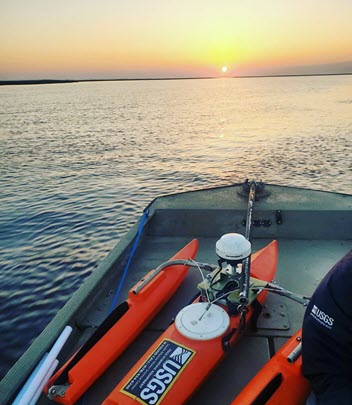
Tifton (Georgia) Bow-mounted ADCP Tethered Rig. This mount can be rotated to deploy ADCPs off of the front of a manned boat.

New Kentucky mount constructed from Speed Rail. This mount can be used to deploy Rio Grande and RiverSurveyor ADCPs. Detailed instructions and parts list.



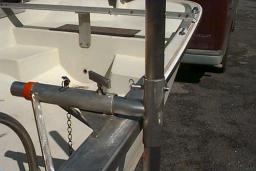


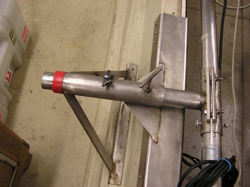
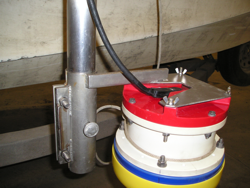
ADCP mounting bracket developed in Ithaca, NY. Contact Hank Zajd for information.
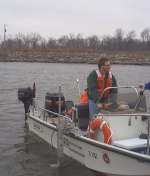
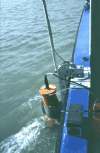
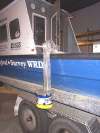
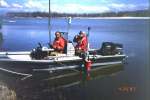
Old custom made Kentucky-style mount on several different boats from Kentucky and Illinois deploying both Broadband (BB) and Rio Grande ADCPs. A pole can be fixed to the mount for deploying a GPS antenna located on top of the ADCP. The new Kentucky-style mount constructed of Speed Rail is recommended for Rio Grande and RiverSurveyor instruments.
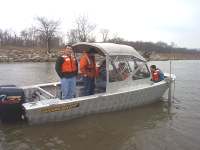
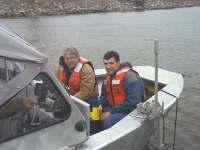
Missouri District boat and mount.

2-speed sailing winch used by the Illinois Water Science Center to make low-flow measurements
on a tagline.
Tethered Boats
A tethered boat can be defined as a small boat (usually less than 2 m long) attached to a rope, or tether, that can be deployed from a bridge, a fixed cableway, or a temporary bank-operated cableway. The tethered boat should be equipped with an ADCP mount that meets all of the specifications outlined in the previous section on manned boats. The tethered boat should also contain a waterproof enclosure capable of housing a power supply and wireless radio modem for data telemetry. A second wireless radio modem attached to the field computer enables communication between the ADCP and field computer without requiring a direct cable connection. The radio modems should reliably communicate with the ADCP using the ADCP data-acquisition software; have a rugged, environmental housing; operate on a 12-volt direct current (DC) power supply; and have at least 38,400 baud data-communication capability to maximize ADCP data throughput (Rehmel and others, 2002).
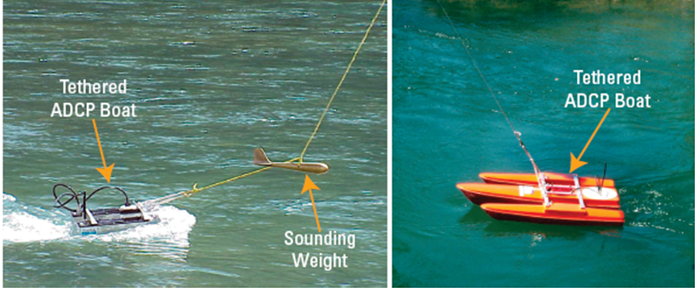
Examples of tethered acoustic Doppler current profiler (ADCP) boats used for making discharge measurements. (Left photograph by Jeff Woodward, Environment Canada and right photograph by Geoffrey D. Cartano, U.S. Geological Survey.)
Tethered ADCP boats have become a common deployment method. Certain considerations need to be made when making tethered ADCP boat measurements. Tethered boats are used in a variety of settings, but primarily from the downstream side of bridges for convenience. Bridge piers can cause excessive turbulence during high streamflow, especially if debris accumulations are present on the piers and the piers are skewed to the flow. The effect of bridge pier-induced turbulence may be reduced by lengthening the tether to increase the distance between the bridge and the tethered boat. Attention should be paid to the cross section to ensure that there are no large eddies that could cause flow to be non-homogeneous. Possible alternatives to measuring off the downstream side of bridges include bank-operated cableways or having personnel on each bank with a rope attached to the platform, pulling it back and forth across the river.
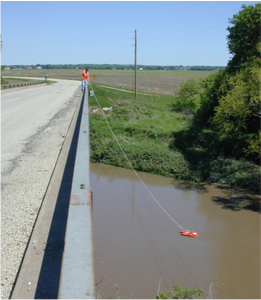
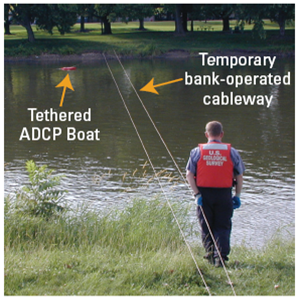
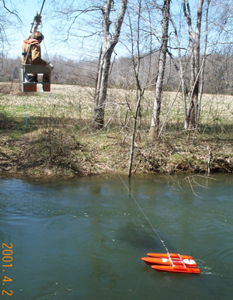
Tethered Boat Manufacturers
Tethered boats can be obtained by purchasing a complete system including ADCP from SonTek/YSI, purchasing the boat and communications for deploying either a TRDI Rio Grande or a SonTek/YSI RiverSurveyor from OceanScience, Inc. or Open Seas Instrumentation, Inc., purchasing only the boat from OceanScience, Inc., and providing your own communications equipment, purchasing a boogie board style hull from Kenu Hawaii and building the mount, enclosures and all communications yourself or by constucting everything yourself.
SonTek/YSI
SonTek/YSI provides to different options for tethered boat deployements. The yellow trimaran is available as an option with a RiverSurveyor or can be purchased from OceanScience, Inc. The Rivercat is a smaller tethered deployment available only from SonTek/YSI.
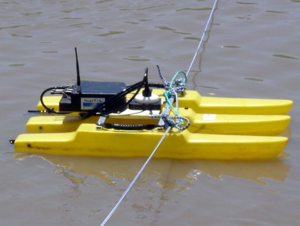
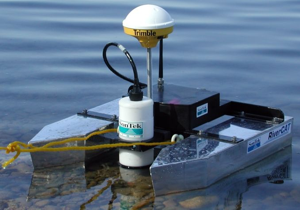
OceanScience, Inc.
OceanScience manufactures tethered boats for TRDI Rio Grandes (shown below) and SonTek/YSI RiverSurveyors. There are several communications options available.
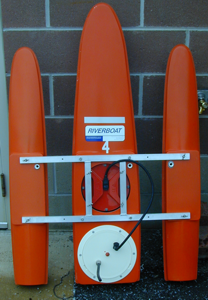
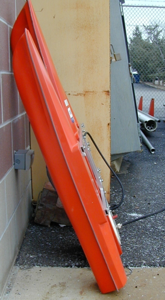
Open Seas Instrumentation, Inc.
Open Seas Instrumentation introduced this tethered boat in 2003. Currently, the USGS has no experience with this boat.
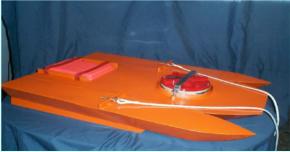
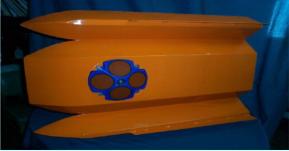
Kenu Hawaii
Kenu Hawaii manufactures a hull (shown below)that can be purchased for a do-it-yourself alternative to the OceanScience boats. Mounting and communications must be designed and constructed yourself (example below by John Shelton). Although this may be a lower-cost alternative, this should only be attempted by users who have a good understanding of the ADCP, communication protocols, and wireless data telemetry. Design of the ADCP mount and the power and communications enclosure should consider the increased drag on the tether that may be experienced if the boat were to flip upside down in the water.
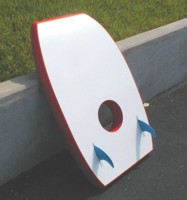
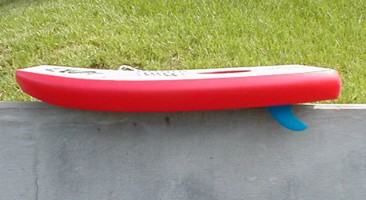
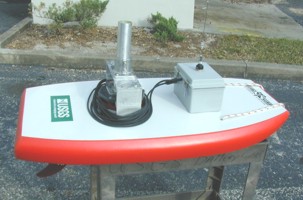
Remote-Control Boats
Unmanned, remote-control ADCP boats allow the deployment of ADCPs where deployment with a manned boat or tethered boat may not be feasible or ideal. Similar to (but smaller than) manned boats, a remote-control boat has self-contained motors and a remote-control system for maneuvering the boat across the river. Unlike the tethered boat, the remote-control boat has no rope (tether) restraints. Although remote-control boats have an increased risk of equipment loss because of potential loss of boat control, they provide the ability to launch a boat without a boat ramp and to collect data away from bridge effects (for example, upstream of a bridge) or at sites where no bridge or cableway is present. Currently remote-control boats are commercially available but extensive field experience with these boats is limited.
OceanScience, Inc.
OceanScience produces two remote-control boats. The boat on the left has canoe style displacement hull and has a maximum speed of about 5 ft/s. The boat on the right has a planning hull and has a maximum speed of about 17 ft/s but data collection beyond about 11 ft/s has not been obtained due to air entrainment beneath the ADCP.

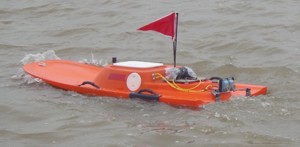
Sea Robotics, Inc.
Sea Robotics offers several boats that can be used to deploy either TRDI or SonTek/YSI ADCPs. These RC Boats provide manual, semi-autonomous, and autonomous control.
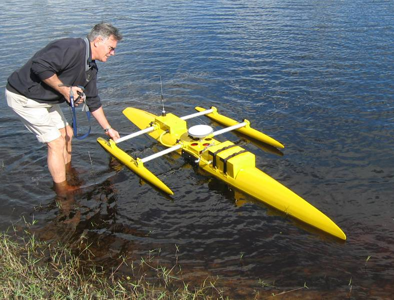
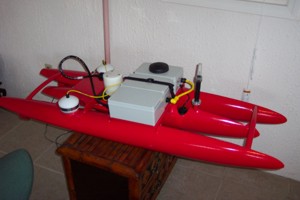
StreamPro
OceanScience, Inc. has designed an alternative boat for the StreamPro that works better in faster and more turbulent flows than the original boat that comes included with the StreamPro.

